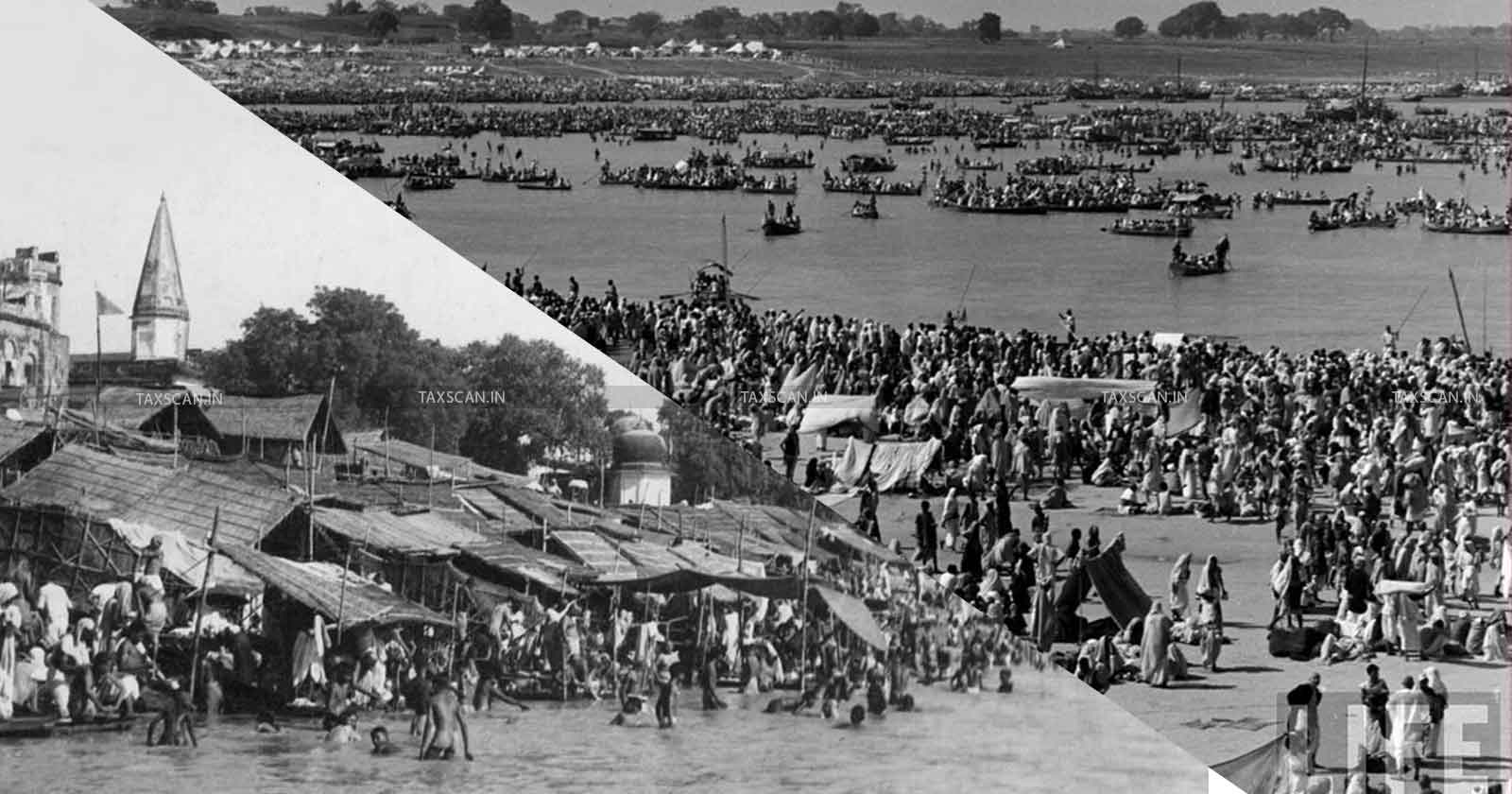The Kumbh Mela Tax - A Price paid on Spirit and Soul
Take a walk down to the origins of the Kumbh Mela as we know it today and the lesser known form of Tax levied in relation to it.

Kumbh Mela tax-Government taxation on pilgrims-Kumbh festival revenue-kumbh mela-Taxscan
Kumbh Mela tax-Government taxation on pilgrims-Kumbh festival revenue-kumbh mela-Taxscan
The Kumbh Mela is one of the most significant religious gatherings in the world, attracting millions of Hindu devotees to the confluence of sacred riverbanks for a ritual dip believed to cleanse sins and bring about spiritual liberation.
Held cyclically at Prayagraj, Haridwar, Nashik, and Ujjain, the Kumbh Mela dates back centuries and derives its origins from Hindu mythology, tracing its roots to the Samudra Manthan (the churning of the ocean) from which the divine nectar, or Amrit, emerged. The event, celebrated every 12 years at each location, witnesses a gargantuan influx of millions of pilgrims, seers, sadhus, and international visitors.
Boost Your Business with SME IPO Funding Strategies - Enroll Now
While the festival is a symbol of faith, devotion, and cultural unity, it has also historically attracted economic and political interest from all quarters. The Kumbh Mela has historically been an economic powerhouse, with governments over the years eyeing it as an opportunity to monetize pilgrimage through taxation and trade.
One of the most controversial instances of such economic intervention was the British-imposed tax on the holy dip in the 19th century.
Read More: FM Nirmala Sitharaman tables New Income Tax Bill in Parliament
British Taxation on the Holy Dip
During the British colonial rule in India, the administration, in an effort to generate revenue from the massive congregation, imposed a tax on pilgrims participating in the Kumbh Mela. The first recorded instance of this tax was in 1895, when pilgrims were charged ₹1 to take the holy dip in the sacred waves.
The taxation was seen as an obstacle planted by the British against the devotees’ freedom to practice religion and to undertake sacred rituals. The British were aware of the devout population’s unwavering faith and sought to capitalize on this by placing the tax.
Despite strong opposition, the tax remained in place and was collected at multiple Kumbh Melas held during British rule. It was only after increasing dissent and nationalistic emotion that the last instance of this ‘Holy Dip Tax’ was recorded in 1940.
Intense resistance from religious leaders and the ever-growing sentiment against British rule and consequent economic exploitation led to the eventual repeal of the tax.
Read More: Broad Scope of New Income Tax Bill 2025: General FAQs Answered
Vocation and Income
The Kumbh Mela is not just a religious gathering but also a thriving marketplace for various professionals. From priests performing rituals to vendors selling religious paraphernalia, food and refreshments, and souvenirs.
Among the multiple people relying on the Kumbh as a source of income there are small traders, boatmen, flower vendors, tailors, barbers and artisans. The Income scale at the time was quite different to the income scales seen today with the average Indian’s monthly income being under ₹10 with tailors earning just about ₹8 a month while sweepers only made ₹4.
And so, the levy of ₹1 tax to take the holy dip created deep dents in the disposable income available to the average Indian.
Tonsure Tariff
Hinduism considers hair as a divine representation of purity and devotion, and so the shaving off of one’s hair was considered one of the key tenets of penance or sacrifice during religious rituals. Among the many traditions observed at the Kumbh Mela is tonsuring. Given the religious significance of this practice, barbers have historically seen a boom in business during the Kumbh Mela.
Recognizing the lucrative nature of the business, the British government set up nearly 3,000 barber stations during the 1870 Kumbh Mela. Imposing a tax of Rs. 4 per barber, the British Government was slated to have collected about ₹10,752 out of the total earned revenue of ₹41,824, as tax from barbers.
This levy was deemed yet another exploitative measure aimed at extracting revenue from devout pilgrims who considered tonsuring an essential part of their spiritual journey. The tax was heavily criticized by local leaders and religious figures, further fueling resentment against British policies further fueling growing calls for self-rule.
Journey to Revolution
The Kumbh Mela was not just an economic and religious affair; it was also a crucial political platform. The sheer size of the gathering made it an ideal venue for nationalist leaders to rally support against British rule.
The 1920s and 1930s Kumbh Melas saw increasing nationalistic activity, with leaders using the congregation to propagate messages of resistance. The arrival of Mahatma Gandhi at the 1936 Prayagraj Kumbh was a turning point. His presence at the mela, combined with widespread opposition to British taxation on religious practices, fueled nationalist fervor. The British, fearing a large-scale uprising, closely monitored the event.
Additionally, in the 1940s, as World War II raged on, British authorities were increasingly anxious about the possibility of Japanese forces infiltrating India. The Kumbh Mela, with its massive crowds, was seen as a potential breeding ground for revolutionary ideas and upheaval of British rule. This fear, combined with the ever-growing discontent against colonial rule, eventually led to increased policing and surveillance at the Kumbh gatherings.
Read More: Union Budget 2025: Detailed List of New & Revised Government Schemes
Economics of the 2025 Kumbh
Fast forward to 2025, and the Kumbh Mela remains a massive economic force. The government has allocated over ₹7,500 crore for infrastructure, sanitation, and security, recognizing the mela’s significance as both a religious and financial event. While no explicit ‘Kumbh Tax’ exists today, various indirect revenue streams contribute to the government’s earnings through:
Accommodation and tourism by means of Luxury tents, hotels, lodges, dormitories and guesthouses.
Increased railway and airfare prices, along with toll charges bring in revenue through transportation.
Traders and food stalls require interested persons to avail vendor licenses and permits, generating revenue for local authorities.
Economists estimate that the 2025 Kumbh could generate over ₹2 lakh crore through spending by attendees, benefiting industries ranging from travel and hospitality to food and retail. The mela is projected to create hundreds of thousands of temporary jobs, further highlighting its economic importance.
Conclusion
The Kumbh Mela has long been a cohesive blend of spirituality, commerce, and politics. From the colonial-era taxes on holy dips and tonsuring to its present-day economic significance, the Kumbh Mela stands alone at its position as one of the highest revenue-generating events held in India.
While the British taxation policies are a thing of the past, the Kumbh continues to generate vast revenue, with the core essence of the Kumbh remaining unchanged—a sacred journey of faith, devotion, and transcendence.
Support our journalism by subscribing to Taxscan premium. Follow us on Telegram for quick updates


